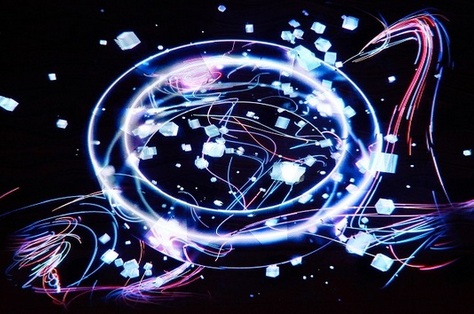
HYPERVSN engineers come up with effective cure for “banner blindness”
Belarus is already called the Eastern European Silicon Valley: 30,000 young web designers and programmers work in the capital of Minsk, which has a population of just over 2 million. Well-known brands such as World of Tanks, Viber, MAPS.ME, Flo, and MSQRD originated here, and the list of IT accomplishments grows daily.
One of the latest developments is the HYPERVSN 3D video system with holographic effect, which makes it possible to imitate a volumetric image in the air. The developers, childhood friends Kirill Chikeyuk and Artem Stavenko, explain that this is not a standard three-dimensional hologram. In the HYPERVSN system, rotating beams create an invisible surface on which a video is broadcast. The system consists of a special “fan” with four blades with LEDs at the tip of each blade. Using a special visual design program, the rapid rotation of the blades is synchronized with the operation of the LEDs. With the blades moving as quickly as possible, the effect is that of a floating image. At the same time, no bulky structures are involved and the image is easily downloaded from a tablet or phone using Wi-Fi.
This seems to be the perfect solution to catch one’s eye. In a world oversaturated with ads, it’s hard to draw the attention of potential customers to anything at all, especially to standard banners. This phenomenon even has a name—banner blindness. But an advertising hologram is simply impossible to ignore.
“We evoke all kinds of emotions in people,” says Artem Stavenko. “Some like it, some don’t, but they all have something in common: they can’t look away!”
In 2017, HYPERVSN, a start-up with a dozen employees, launched mass production and scored its first customers in hologram rendering: Red Bull, McDonalds and Virgin Media. A year later, the company’s managers turned to the European Bank for Reconstruction and Development for help. With the support of the EBRD and the EU4Business initiative, the company hired local consultants to implement an integrated customer and enterprise resource management system and received partial compensation for their project expenses. Thanks to this support, HYPERVSN improved the quality of processing, information exchange and communication with suppliers, which allowed them to see better productivity and increase the company’s net profits.
By the end of 2019, the HYPRVSN system was employing 150, and global brands such as Adidas, Samsung, Coca Cola and Louis Vuitton joined the crowd of admirers of hologram advertising. The company plans to expand their services to include interactive holograms for education and healthcare, among others.
HYPERVSN’s developers know that a picture’s worth a thousand words. And it is hard to argue with that!